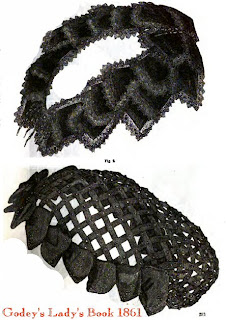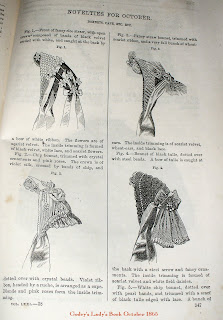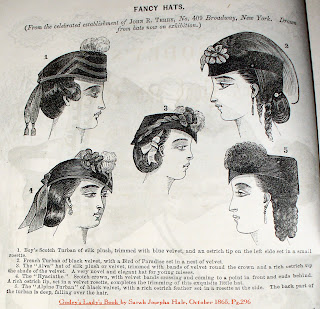This post is for Atlanta at The Story of a Seamstress' new site for beginning Civil War reenactors.
Head coverings were a must during the 1850s. Cloth caps were worn indoors in the morning and also to sleep in. Bonnets and hats were worn outside. Large sunbonnets were worn outdoors in the country. Wealthier women wore hats with veils. Pale skin was coveted during the period so even working women covered up to protect their skin. Some women did not cover their heads outside but it was the exception rather than the rule and an uncovered head was synonymous with a "fast lifestyle."
Prior to the war most women had between 4-12 bonnets per year, the average being closer to 4. During the blockade, many Southern women had to learn to do without and refashion their bonnets with anything they could. Bonnets were one of the first things women had to learn to do without. Makeshift bonnets and hats were made from palmetto leaves. Bonnets were worn in church and on short social calls, this heightened the demand.
Even the rich could not get new bonnets in the South due to the blockade. Sarah Morgan, a Southern teenager when the war began, wrote in her diary that "Colonel Breaux paid my hair the most extravagant compliments. He said he could not say his prayers for looking at it in church, Sunday before last. Perhaps that is the reason St. Paul said a woman should not worship in church with her head uncovered! But as the Yankees stole my bonnet, I am reduced to wearing my black straw walking-hat with its curled brim, trimmed in black ribbon with golden sheaves of wheat. Two years ago this fall, father threw me a banknote at table, and I purchased this with it. Now it is my only headgear, except a sunbonnet."
Winter
Hopefully these pictures will help beginning reenactors see which styles are appropriate. Bonnets and hats were normally purchased and few made their bonnets at home. Make sure your bonnet is made in a period correct style and out of period correct fabrics. Fine silks, velvets, lace and ribbons were used for hats and bonnets, a beginner mistake is to use cotton. Cotton was not used for bonnets; if you wish to make a summer bonnet, leave the bonnet uncovered and add the trim right on top of the straw braid.
Head coverings were a must during the 1850s. Cloth caps were worn indoors in the morning and also to sleep in. Bonnets and hats were worn outside. Large sunbonnets were worn outdoors in the country. Wealthier women wore hats with veils. Pale skin was coveted during the period so even working women covered up to protect their skin. Some women did not cover their heads outside but it was the exception rather than the rule and an uncovered head was synonymous with a "fast lifestyle."
Prior to the war most women had between 4-12 bonnets per year, the average being closer to 4. During the blockade, many Southern women had to learn to do without and refashion their bonnets with anything they could. Bonnets were one of the first things women had to learn to do without. Makeshift bonnets and hats were made from palmetto leaves. Bonnets were worn in church and on short social calls, this heightened the demand.
Even the rich could not get new bonnets in the South due to the blockade. Sarah Morgan, a Southern teenager when the war began, wrote in her diary that "Colonel Breaux paid my hair the most extravagant compliments. He said he could not say his prayers for looking at it in church, Sunday before last. Perhaps that is the reason St. Paul said a woman should not worship in church with her head uncovered! But as the Yankees stole my bonnet, I am reduced to wearing my black straw walking-hat with its curled brim, trimmed in black ribbon with golden sheaves of wheat. Two years ago this fall, father threw me a banknote at table, and I purchased this with it. Now it is my only headgear, except a sunbonnet."
Period Examples of Head Coverings:
Caps
Caps
Winter















Hi thanks for asking for my blog address. Here it is:
ReplyDeletehttp://theupperroad.blogspot.com/
you are very welcome to visit my blog. I am looking forward to hear from you!
I am sorry that I did not get back sooner on this.
~Grace
please delete this comment ~thanks
Thanks so much!
ReplyDelete